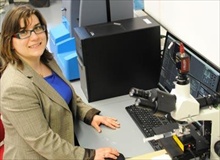Members Login

Channels
Special Offers & Promotions
Radboud University Nijmegen applies nanoparticle tracking analysis from NanoSight to study molecular machines
 NanoSight, leading manufacturers of unique nanoparticle characterization technology, report on how the Radboud University Nijmegen is applying nanoparticle tracking analysis for the characterization of self-assembled nanomotors.
NanoSight, leading manufacturers of unique nanoparticle characterization technology, report on how the Radboud University Nijmegen is applying nanoparticle tracking analysis for the characterization of self-assembled nanomotors. The oldest city in the Netherlands has provided the home for the latest exciting development in nanotechnology. Jet-engined nano-size rockets may provide a solution for delivering drug packages in the human body. This is not science fiction; it is science fact! Nature Chemistry has published a paper outlining the latest work of Daniela A. Wilson, Roeland J. M. Nolte and Jan C. M. van Hest from the Institute for Molecules and Materials (IMM), Radboud University, Nijmegen.
Dr Daniela A. Wilson explains the work of the group. "Making a nanomotor has been a dream of many researchers in nanotechnology. From molecular machines to micron size self-propelling rods, our team has used a combination of bottom-up or top-down approaches taking years off synthetic work. We applied self-assembly as a tool just like the pieces of a puzzle. The only difference is that we allowed the building blocks make itself to form 350 nm sized motors. The next step was to prove the concept. Having constructed these sub-micron sized nanomotors, we could not use conventional microscopies to visualize them. For 350 nm size particles, we required a special technique and this is how we have come to be users of the NanoSight technique of nanoparticle tracking analysis, NTA. This tracks the motors one by one (in effect, particle-by-particle). We could even analyze their movement after the addition of their fuel (hydrogen peroxide)."
Dr Wilson continued: "Knowing the particle size was very important to establish the size distribution of our self-assembled nanomotors as well the entrapment of the catalytic particles inside the bowl shape structures. However, even more important for us was the ability to track the movement of the motors in the presence of the fuel. This provided the definitive proof of directed motion resulting from the fast discharge of oxygen."
Prior to using NTA, the IMM group used dynamic light scattering (DLS). While quite powerful to measure size, it did not provide the ability to track individual particles that was essential for this research. Furthermore, it was vital to be able to analyze particle movement in real time. NanoSight uses tracking and scattering information to provide the size of the particles as well as giving information about the purity of its components. Different refractive indexes materials within the same colloidal distribution will give different scattering and therefore the group is able to use that information to assess the purity and distribution of complex mixtures.
To find out about the company and to learn more about particle characterization using NanoSight's unique nanoparticle tracking analysis solutions, visit www.nanosight.com and register to receive the next issue of NanoTrail, the company's electronic newsletter.
Media Partners


